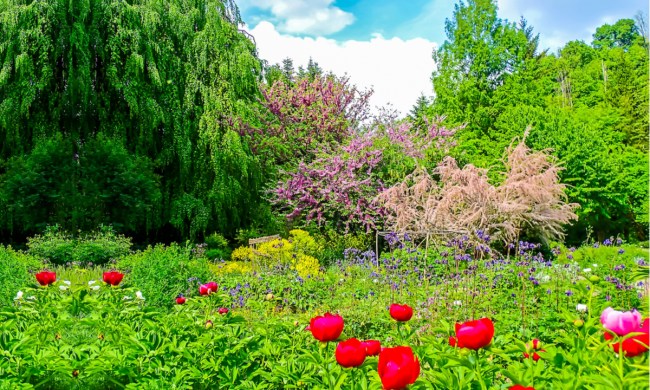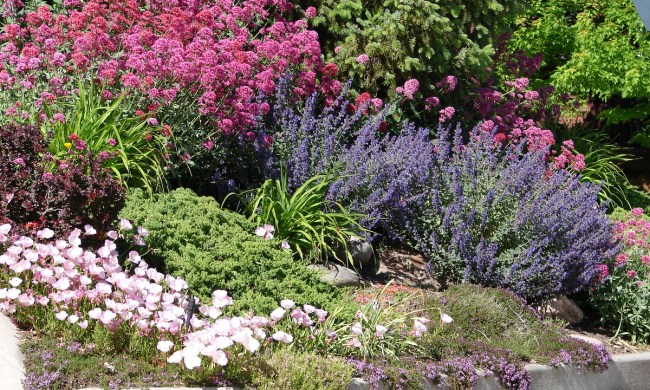Garden beds are a classic way of organizing a garden, and they’re excellent for creating separate spaces that have different aesthetics or themes. However, there is a catch. If you want your garden beds to be unique areas, you need to keep them from blending into the rest of your yard or garden. If the edges aren’t neat, it can be difficult to tell where the bed begins and ends. Rough edges don’t just impact the aesthetics of your garden beds, though. They can also make certain parts of caring for your garden more difficult. To keep your garden beds orderly, here are a few landscape edging ideas for you to try.
What is landscape edging?

Landscape edging is a border between a garden bed and the rest of your garden or yard. They can look like almost anything, from a small wall to a decorative fence, and serve several functions. Aesthetically, they set the garden bed apart from the rest of the area, making it a contained unit. If you’re a fan of English country gardens, landscape edging can help you achieve the same effect in a smaller space.
From a practical perspective, landscape edging can also make care easier. It can slow or stop your plants from spreading outside their bounds. Providing a boundary also makes mowing your lawn near the garden bed easier, since there’s a physical border stopping you from accidentally mowing over your plants. Landscape edging can also stop wind and water from carrying away your mulch, so you won’t have to replace it every time it rains.
Bricks

Bricks are a simple and easily accessible landscape edging option, and they’re surprisingly versatile. A single row of bricks along the edges of a garden bed can prevent your mulch from escaping without drawing too much attention away from the plants. For garden beds that aren’t rectangular, curved bricks are useful without altering your garden bed. If you want something more refined, you can use black or gray bricks, while a more whimsical garden might benefit from colorful, hand-painted bricks. You can even use sidewalk chalk to change the designs whenever you want.
You can also stack your bricks to form a low wall to protect taller plants, create a raised garden bed, or simply to enjoy the way it looks. Just remember to use mortar or another type of construction adhesive to keep your wall from falling apart.
Rough wood

If you want something with a more natural aesthetic, rough wood is a great option. If you have trees or brush on your property, then you won’t even need to go shopping, making this a cost-effective option as well. Rather than the clean, polished look of wood boards, rough wood logs and large branches look more rustic.
If you’re gathering your own wood, check for pests before bringing it to your garden. You may need to cut larger pieces down in order to make them fit the specifications of your garden. Since branches don’t fit together as snuggly, mulch may still escape, but a rough wood border will still make mowing around your bed easier.
Miniature fence

Miniature fences are a versatile option that can fit most aesthetics. From simple picket fences to elegant wrought iron ones, mini fences are a great way to set your garden bed apart in a more visible way. While some fences leave gaps between the posts and aren’t great for keeping mulch in place, others fit closer together to keep mulch in place.
Any fence will make mowing easier and will set your bed apart visually. They’re also easy to find in a wide range of colors, styles, and materials. Wood, metal, and plastic fences are all found in most garden and landscaping stores, and you can paint or decorate most of them at home to give them some extra flair. Some miniature fences can even be a trellis for small vines.
Natural stone

If you want a charming, natural material that’s more durable than wood, then one of the many stone landscape edging options will be perfect for you. You can use carved or shaped stone pavers for an effect similar to the brick landscape edging ideas, or opt for something more natural looking, like round or rough rock.
Chunky boulders and smooth river rocks are all options, and you can choose different types of rocks for a range of aesthetics. Just like with bricks, you can paint or decorate them yourself to make them more colorful, and flat stones are perfect for crafting walls.
These landscape edging ideas are a great jumping-off point, but it’s important to remember that there aren’t any hard-and-fast rules. Think about what type of garden you would like to have, and then match your edge to that. As long as you’re happy with the way it looks and it isn’t harming your plants, it’s the perfect garden border.




